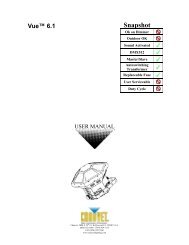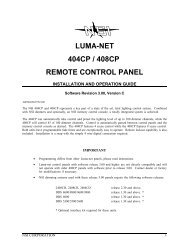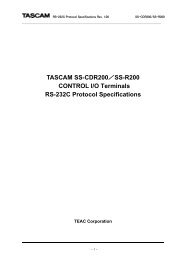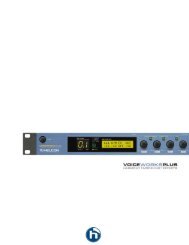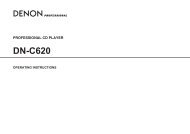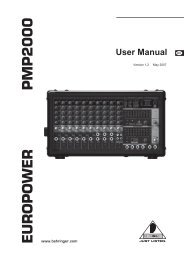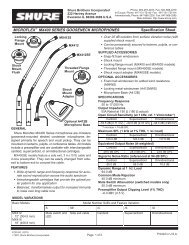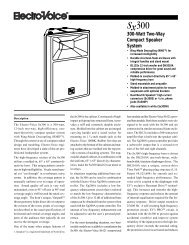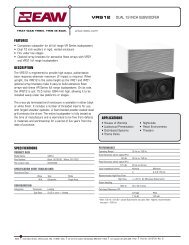Owner's Manual & Installation Guide - JBL Professional
Owner's Manual & Installation Guide - JBL Professional
Owner's Manual & Installation Guide - JBL Professional
Create successful ePaper yourself
Turn your PDF publications into a flip-book with our unique Google optimized e-Paper software.
<strong>Guide</strong> to the Pins for Connection -- The removable locking<br />
input connector contains 4 terminals, as marked on the connector.<br />
The pin functions are listed on the label located on the<br />
terminal cover plate.<br />
+<br />
IN<br />
CONNECTION<br />
1 2 3 4<br />
–<br />
IN<br />
+<br />
Loop<br />
Thru<br />
–<br />
Loop<br />
Thru<br />
Figure 6<br />
Connecteor Pins<br />
Pins 1 & 2 are the “+” and “-” inputs to the loudspeaker. Pins 1<br />
& 2 are looped to pins 3 & 4, respectively (Pin 1 connects to Pin<br />
3 and Pin 2 connects to Pin 4) inside the speaker. Pins 3 & 4 are<br />
intended as loop-through connections to subsequent loudspeakers.<br />
There are two possible hookup schemes for connecting<br />
subsequent speakers, determined by the desired result from<br />
the circuit whenever this speaker’s connector gets disconnected<br />
during troubleshooting:<br />
Paralleling Input Terminals -- Connect the wire pair of the<br />
subsequent speaker to pins 1 & 2 (in parallel with the input<br />
wire pair). Whenever the connector is pulled out of the<br />
speaker for troubleshooting, subsequent speakers will stay<br />
connected. This can be useful during troubleshooting to<br />
be able to disconnect a single loudspeaker at a time. In this<br />
hookup scheme, no wires get connected to pins 3 & 4.<br />
From Amplifier<br />
or Previous<br />
Speaker<br />
Power + -<br />
Amplifier<br />
Power +<br />
-<br />
+ - ‘<br />
Figure 9:<br />
Using Loop-Through Terminals<br />
Speaker 1 Speaker 2 Speaker 3<br />
Figure 10:<br />
Loop-Through System Hookup Diagram<br />
To Subsequent<br />
Speaker(s)<br />
Choose whichever hookup pattern accommodates your installation<br />
best.<br />
Step 4 – Open the Strain Relief Fitting / Terminal<br />
Cover<br />
-<br />
+<br />
To<br />
+<br />
To Subsequent<br />
Subsequent<br />
Speakers<br />
- Speaker(s)<br />
From Amplifier<br />
or Previous<br />
Speaker<br />
+ - ‘<br />
+ -<br />
Power Amplifier<br />
Amplifier<br />
Figure 7:<br />
Paralleling Input Terminals<br />
Speaker 1 Speaker 2 Speaker 3<br />
Figure 8:<br />
Parallel System Hookup Diagram<br />
To Subsequent<br />
Speaker(s)<br />
To<br />
Subsequent<br />
Speaker(s)<br />
+ To<br />
Subsequent<br />
- Speakers<br />
Figure 11:<br />
Open the strain relief fitting by loosening the two set screws in<br />
the backcan, then loosen the two horizontal screws, and slide<br />
open the sliding cover.<br />
Loosen the screws holding the fitting’s sliding piece of the input-terminal<br />
cover and slide the cover open.<br />
Step 5 – Plug connector into connector socket in<br />
the speaker’s terminal cup.<br />
Using Loop-Through Terminals (Pins 3 & 4) -- By connecting<br />
the wire pair of the subsequent speaker to pins 3 & 4,<br />
then all subsequent speakers will be disconnected when this<br />
speaker’s connector is disconnected during troubleshooting,.<br />
This can be useful as a way to isolate problems to a section<br />
of the distributed line while leaving the wires attached to the<br />
connector.<br />
5<br />
Figure 12:<br />
Plug Connector into Connector Socket. Shown with a single<br />
cable (left) or with two cables for input and loop-through (right)




